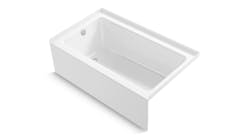Latest from Geothermal
Sponsored
By Rose Morrison
Geothermal energy pumps are a cost-effective heating and cooling solution that can offer some major benefits for building owners wanting to make their property a little more green.
Over time, a geothermal energy system can help a building owner cut down on heating and cooling costs by 65% or even more. The tech can also reduce greenhouse gas emissions by around 40%. Implementing renewable energy is more important now than ever, considering the U.S. generated 1,619 million metric tons of greenhouse gas emissions last year.
The high upfront cost of installing a new system, however, can easily dissuade even a committed building owner, even if they own property in the perfect location for a geothermal system.
Contractors should know that available tax credits, financing options and the potential ROI of geothermal energy makes it possible for building owners to quickly recoup the cost of investing in one of these systems — if they have the right resources and knowledge at their disposal.
In this article, we’ll discuss how contractors can make geothermal systems more feasible for building owners who may be reluctant to make the large up-front investment necessary.
Installation
Geothermal pumps aren’t new technology. In the United States, they’ve been in use since the 1940s and European power companies began collecting geothermal power at scale even earlier. However, the cost of geothermal systems—whether they’re being retrofit to an existing structure or added to a brand-new home—remains high.
On average, a new system will cost anywhere between $10,000 and $30,000, depending on factors like soil quality, site accessibility and the amount of digging required. Installing one of these systems in a new home or building is typically cheaper than a retrofit—but even under ideal conditions, a geothermal pump will cost around 40% more than a conventional HVAC system.
Depending on local utility costs, this means that a geothermal system will pay for itself in anywhere between 4 to 15 years. Even in the best-case scenario, building owners will have to wait a long time to before they see any return on investment.
Building owners and contractors can take a few different steps to lower the costs of geothermal system installation.
Cutting down the cost of the building project in general is a good place to start. Best practices for managing project costs include overseeing labor efficiency, implementing technology to prevent errors, and choosing cost-effective building materials and equipment.
If you need extra equipment for the job, choosing a high-hour used machine can help you save money, so long as you know what to look for when selecting the machine. A used machine, even one that’s seen serious work hours, can be just as effective as a new one—and much cheaper—if it’s been properly serviced and maintained.
The type of system that a building owner chooses can also affect the cost. Depending on the soil quality of the site, a vertical system may be more cost-effective than a horizontal one. It may also be possible to take advantage of local bodies of water—like a pond or lake—to significantly reduce installation cost.
While these systems will be more expensive to install than a conventional HVAC system, this doesn’t mean that building owners need to wait for ROI to recoup the costs.
Tax Credits
There are two main tax credits that building owners can take advantage of to significantly reduce the upfront cost of a new geothermal pump.
For non-business property owners, the biggest is the 26 percent residential energy efficient property credit. The credit allows homeowners—or other nonbusiness property owners—a tax reduction equal to a certain percent of new, energy-efficient construction, such as solar panels, wind turbines and geothermal heat pumps.
The credit’s value steps down to 22 percent in 2021 before being phased out altogether the year after. The renewable energy industry has been lobbying to extend the credit, but as of October 2020, it’s still set to expire on January 1, 2022.
Installed pumps need to meet certain baseline requirements around energy-efficiency and performance—but otherwise, there are no special requirements for geothermal systems in order for building owners to qualify for the credit.
However, because the credit will be phased out after 2021, building owners would need to break ground on a retrofit or new system soon. Systems only qualify for the tax in the year they are “placed in service,” according to the IRS, meaning that homeowners will need to start and finish their project fairly quickly.
For businesses, there is also the Business Energy Investment Tax Credit (ITC). This credit offers a comparable reduction for business property owners—26 percent in 2020, stepping down to 22 percent in 2021. Unlike the residential equivalent, this credit won’t be phased out entirely —instead, it will remain as a permanent, 10 percent tax credit starting on January 1, 2022.
Local Programs
Local initiatives may provide further savings. The Database of State Incentives for Renewables & Efficiency (DSIRE) maintains a list of federal, state and local programs on its website. The list is filterable by technology, meaning that building owners can look for programs guaranteed to apply to geothermal systems.
Depending on the location of a building, owners may also be able to take advantage of local utility projects to cut down on costs.
For example, there’s the Western Farmers Electric Cooperative in Oklahoma. Three member cooperatives of the WFEC launched a new utility program, where the cooperatives offer managed geothermal energy as an option to local homeowners.
In this case, the utility itself manages the installation process and maintenance of new systems, then bills the homeowner a fixed monthly service charge, based on the size of loop provided.
Financing Options
If these tax credits aren’t enough to make a project economically workable, financing options can also help. For homeowners, home equity loans and HUD Title 1 property improvement loans can help provide some of the necessary money for initial building costs.
Some geothermal providers partner with private lending companies and may offer credit and long-term loans that can help building owners get started on a new project.
Geothermal is Possible
Building owners can cut down on both heating costs and emissions with a geothermal pump system. However, the cost of these systems is often a major roadblock for projects.
Federal tax credits, local initiatives and adjustments to the construction process — like taking advantage of a local body of water — can help significantly reduce the cost of a geothermal system.
Rose Morrison is a freelance writer who covers construction, home improvement, and contracting topics. She is also the managing editor of Renovated.com, a site dedicated to the latest trends in the home industry. She has a passion for innovative technologies that are making the home industry sustainable and efficient. Check out Renovated.com to see more of her work.


